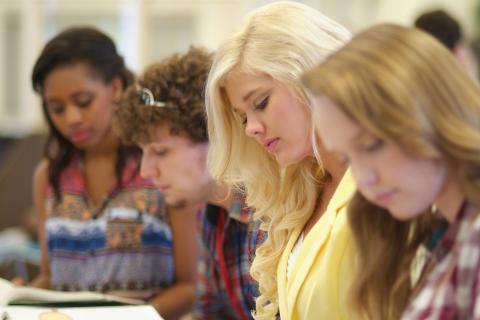Clean Gymnastics
by Marian Way in Education

I went to Coggeshall in Essex to spend a day in a primary school classroom, with Julie McCracken, who has introduced her 5, 6 and 7 year-olds to the joys of Clean Language. Julie has written a book on Clean in the Classroom, so I’ve heard many tales of clean goings-on, but this was the first chance I got to see for myself how the children responded to clean questions (they call them the ‘Detail Detective’ questions). It was an action-packed day, with children both asking and answering the questions. This post is about what happened in the gym lesson.
Once the children were changed and in the hall, Julie reminded them of a metaphor they were already familiar with: that they should imagine having a ‘string that reaches from the top of your head to the sky’. This got them all sitting up straight and was a great way of reminding them to have good posture throughout the lesson. Instead of nagging them to sit up straight, she simply said, “Strings on.”
The lesson centred around the children creating sequences of stretching, balancing and travelling, on apparatus and floor mats. After they’d had a go, she talked them through a visualisation where they imagined themselves being on TV in a gymnastics competition, and they were to step into their TV self, and do their sequence again. Then came the ‘clean’ bit of the lesson: one child from each group performed their sequence while everyone else looked on. Julie asked the onlookers to notice for good quality movements and good ideas, and when the performers had finished she asked them what they noticed:
- Child 1: I liked A’s balance.
- Julie: Oh you liked her balance. And what kind of balance was that?
- Child 1: Straight and tall.
- Julie: And is there anything else about that balance?
- Child 1: Yes, her head wasn’t a bit wonky on its side. It was straight up.
Julie then asked A to repeat her sequence, so that everyone could see what had been noticed.
This way of doing things meant the praise was coming from another child rather than the teacher. Julie trusted that they had enough knowledge about gymnastics to be able to recognise a good move when they saw one. And by having the child show everyone the move again, they all got a chance to learn what a ‘good’ move looked like and to associate it with words like ‘straight and tall”. So they were learning from each other, rather from the ‘expert’. And since the children’s own words were used, there was also no chance of Julie using words that the children wouldn’t understand.
Here are a couple more examples:
- Child 2: I liked B’s jump.
- Julie: What kind of jump was that?
- Child 2: She did it straight like a pencil jump.
- Child 3: I liked C’s forward roll.
- Julie: And you liked his forward roll. And is there anything else about that forward roll?
- Child 3: He did it in a kind of circle then went off and stood up at the end.
After a few of these short dialogues (each followed by a repeat performance), the questions started to become unnecessary because the children realised they needed to explain their thinking, so…
- Child 4: I thought D was very good because when she bounced on the bench she had her string on.
- Child 5: E was straight and at the right angle.
Then came this one:
- Child 6: C’s roll was a bit good.
- Julie: Is there anything else about a bit good?
- Child 6: She was doing it beautiful.
- Julie: What kind of beautiful?
- Child 6: Very beautiful.
- Child 7: If it was a bit good, what could she do to make it a bit gooder?
- Child 6: She could tuck her legs in.
- Julie: She could tuck her legs in.
Again, Julie stayed clean, and after a few exchanges another child, who’d picked up on the assumption in the original statement that there was room for improvement, asked a clean-ish question in the spirit of enquiry to help the performer know how it could be improved.
After this “clean interlude” in the lesson, Julie asked everyone to run through in their minds what they’d learned about really good moves and to see if they could incorporate it in their work. And off they went, striving to make the best moves they could in their sequences. I am no expert in gymnastics but I could see a big improvement between the children’s first attempt and what they were doing by the end of the lesson. And Julie hadn’t given them a single instruction about how to move, or singled out any child as being a model to watch. They had done it all by themselves.
Related blog posts
A New Way of Learning Scales and Arpeggios
14th Aug 2013
Reflection in Education
9th Jan 2016
About Marian Way
A highly skilled facilitator and trainer, Marian, who founded Clean Learning in 2001, has developed and delivered training across the world. She is the author of Clean Approaches for Coaches, co-author, with James Lawley, of Insights in Space and co-author, with Caitlin Walker, of So you want to be… #DramaFree.
Marian is an expert Clean facilitator, an adept modeller, a programme writer and an inspirational trainer. She has a natural ability to model existing structures, find the connections between them and design new ways for people to learn. Marian was a leading innovator within the Weight Watchers organisation, which included developing the “points” strategy, a local idea that went on to become a global innovation. She is a director of both Clean Learning and Training Attention CIC, world leaders in clean applications for corporate, educational and community development. She designs our programmes and workbooks, leads workshops and teaches on all our courses. She’s trained people in Great Britain, Russia, Sweden, Germany, Australia, Japan and the USA. Marian is also a recognised Clean Assessor.
- Blog categories
- A - Z of Clean
- Adventures in Clean
- Book Reviews
- Business
- Clean Ambassadors
- Clean Interviewing
- Clean is like ...
- Clean Language
- Clean Language Questions
- Clean Space
- Client Stories
- Coaching
- Creativity
- #DramaFree
- Education
- Health
- ICF
- Life Purpose
- Listening
- Metaphor
- Modelling
- Outcomes
- Practice Group
- Symbolic Modelling
- Systemic Modelling
- Training

